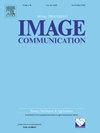GAN-based multi-view video coding with spatio-temporal EPI reconstruction
IF 3.4
3区 工程技术
Q2 ENGINEERING, ELECTRICAL & ELECTRONIC
引用次数: 0
Abstract
The introduction of multiple viewpoints in video scenes inevitably increases the bitrates required for storage and transmission. To reduce bitrates, researchers have developed methods to skip intermediate viewpoints during compression and delivery, and ultimately reconstruct them using Side Information (SInfo). Typically, depth maps are used to construct SInfo. However, these methods suffer from reconstruction inaccuracies and inherently high bitrates. In this paper, we propose a novel multi-view video coding method that leverages the image generation capabilities of Generative Adversarial Network (GAN) to improve the reconstruction accuracy of SInfo. Additionally, we consider incorporating information from adjacent temporal and spatial viewpoints to further reduce SInfo redundancy. At the encoder, we construct a spatio-temporal Epipolar Plane Image (EPI) and further utilize a convolutional network to extract the latent code of a GAN as SInfo. At the decoder, we combine the SInfo and adjacent viewpoints to reconstruct intermediate views using the GAN generator. Specifically, we establish a joint encoder constraint for reconstruction cost and SInfo entropy to achieve an optimal trade-off between reconstruction quality and bitrate overhead. Experiments demonstrate the significant improvement in Rate–Distortion (RD) performance compared to state-of-the-art methods.
基于gan的时空EPI重构多视点视频编码
在视频场景中引入多视点不可避免地增加了存储和传输所需的比特率。为了降低比特率,研究人员开发了在压缩和传输过程中跳过中间视点的方法,并最终使用侧信息(SInfo)重建它们。通常,深度图用于构造SInfo。然而,这些方法存在重构不准确和固有的高比特率的问题。在本文中,我们提出了一种新的多视点视频编码方法,利用生成对抗网络(GAN)的图像生成能力来提高SInfo的重建精度。此外,我们考虑合并来自相邻时空视点的信息,以进一步减少SInfo冗余。在编码器上,我们构建了一个时空极平面图像(EPI),并进一步利用卷积网络提取GAN的潜在编码作为SInfo。在解码器中,我们结合SInfo和相邻视点,使用GAN生成器重建中间视点。具体来说,我们建立了重建成本和SInfo熵的联合编码器约束,以实现重建质量和比特率开销之间的最佳权衡。实验表明,与最先进的方法相比,该方法在率失真(RD)性能方面有显著改善。
本文章由计算机程序翻译,如有差异,请以英文原文为准。
求助全文
约1分钟内获得全文
求助全文
来源期刊

Signal Processing-Image Communication
工程技术-工程:电子与电气
CiteScore
8.40
自引率
2.90%
发文量
138
审稿时长
5.2 months
期刊介绍:
Signal Processing: Image Communication is an international journal for the development of the theory and practice of image communication. Its primary objectives are the following:
To present a forum for the advancement of theory and practice of image communication.
To stimulate cross-fertilization between areas similar in nature which have traditionally been separated, for example, various aspects of visual communications and information systems.
To contribute to a rapid information exchange between the industrial and academic environments.
The editorial policy and the technical content of the journal are the responsibility of the Editor-in-Chief, the Area Editors and the Advisory Editors. The Journal is self-supporting from subscription income and contains a minimum amount of advertisements. Advertisements are subject to the prior approval of the Editor-in-Chief. The journal welcomes contributions from every country in the world.
Signal Processing: Image Communication publishes articles relating to aspects of the design, implementation and use of image communication systems. The journal features original research work, tutorial and review articles, and accounts of practical developments.
Subjects of interest include image/video coding, 3D video representations and compression, 3D graphics and animation compression, HDTV and 3DTV systems, video adaptation, video over IP, peer-to-peer video networking, interactive visual communication, multi-user video conferencing, wireless video broadcasting and communication, visual surveillance, 2D and 3D image/video quality measures, pre/post processing, video restoration and super-resolution, multi-camera video analysis, motion analysis, content-based image/video indexing and retrieval, face and gesture processing, video synthesis, 2D and 3D image/video acquisition and display technologies, architectures for image/video processing and communication.
 求助内容:
求助内容: 应助结果提醒方式:
应助结果提醒方式:


